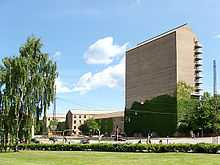Aarhus
| Aarhus | |
|---|---|
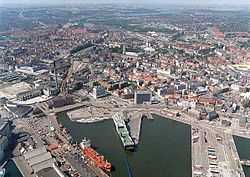 | |
 Aarhus | |
| Coordinates: 56°09′N 10°13′E / 56.150°N 10.217°E | |
| Country | Denmark |
| Region | Central Denmark (Midtjylland) |
| Municipality | Aarhus |
| Area[1] | |
| • Urban | 91 km2 (35 sq mi) |
| • Metro | 9,997 km2 (3,860 sq mi) |
| • Municipal | 468 km2 (181 sq mi) |
| Elevation | 0 m (0 ft) |
| Population (2013)[1][2] | |
| • Urban | 256,018 |
| • Urban density | 2,669/km2 (6,910/sq mi) |
| • Metro | 1,245,046 (17 municipalities in East Jutland metropolitan area) |
| • Metro density | 124/km2 (320/sq mi) |
| • Municipal | 323,644[3] |
| • Municipal Density | 681/km2 (1,760/sq mi) |
| Time zone | Central Europe Time (UTC+1) |
| Postal code | 8000, 8200, 8210 |
| Area code(s) | (+45) 8 |
| Website | Official website |
Aarhus or Århus (Danish pronunciation: [ˈɒːhuːˀs] (![]() )) is the second-largest city in Denmark. The principal port of Denmark, Aarhus is on the east side of the peninsula of Jutland in the geographical centre of Denmark. Aarhus is the seat of the council of Aarhus municipality with 323,644[3] inhabitants and 256,018 (1 January 2013)[2] in the urban area.
Aarhus municipality claims a population of 1.2 million people in the greater Aarhus area.[4][5] The city claims the unofficial title "Capital of Jutland".[6]
)) is the second-largest city in Denmark. The principal port of Denmark, Aarhus is on the east side of the peninsula of Jutland in the geographical centre of Denmark. Aarhus is the seat of the council of Aarhus municipality with 323,644[3] inhabitants and 256,018 (1 January 2013)[2] in the urban area.
Aarhus municipality claims a population of 1.2 million people in the greater Aarhus area.[4][5] The city claims the unofficial title "Capital of Jutland".[6]
Aarhus is the biggest single city in the East Jutland metropolitan area (Danish: Byregion Østjylland), which is a co-operation in eastern Jutland with 17 municipalities.[1] With more than 1.2 million people living in the East Jutland metropolitan area it represents approximately 23% of the population of Denmark. Aarhus has the second-largest urban area in Denmark after Copenhagen.[7]
Name

The city was mentioned for the first time by Adam of Bremen who stated that "Reginbrand, bishop of the church of Aarhus (Harusa)" participated in a church meeting in the city of Ingelheim in Germany.[8]
During the Middle Ages the city was called Arus, and in Icelandic chronicles, it was known as Áróss. It is a compound of the two words ār, genitive of ā ("river", Modern Danish å) and ōss ("mouth", Modern Danish munding; in Modern Icelandic this word is still used for "river delta").[citation needed] The name originates from the city's location around the mouth of the stream Aarhus Å (English: Aarhus River[9]),[10] Å being the Danish word for a small river.[11]
Through regular sound development, Medieval Danish Arus became Aars or Oes, a form which persisted in the dialects of the surrounding parishes until the 20th century. In 1406, Aarhus became prevalent in the written sources, and gradually became the norm in the 17th century. [citation needed] Today, the city is also called "The City of Smiles" among people in Denmark.
Aarhus/Århus spelling
With the Danish spelling reform of 1948 Aa was changed to Å. Some Danish cities resisted the new spelling of their names, notably Aalborg and Aabenraa. Contrarily, Århus city council explicitly embraced the new spelling, thought to enhance an image of progressiveness.
In 2010, a majority of the city council voted for a name change from Århus back to Aarhus, and the renaming came into effect on January 1, 2011.[12][13][14] Mayor at that time Nicolai Wammen argued that the Aa spelling would strengthen the city's international profile, help private enterprise and make it easier to access Aarhus on the Internet.[15] The Aarhus spelling has, however, always had some use in non-Scandinavian languages. There is considerable opposition to the Aa spelling and according to a May 2011 poll 59.8% of the city's inhabitants preferred the Å spelling.[16]
Although the name on many signs and other physical media still reads Århus, official informational websites have effectively altered occurrences of Århus to Aarhus. Furthermore, certain geographically affiliated names have been updated to reflect the name of the city. An example is the Aarhus River for which the Danish name has been altered from Århus Å to Aarhus Å.[9] However, in Danish it is always correct to write geographical names with the letter Å, while local councils since 1984 have been allowed to use the Aa spelling as an alternative option. When a local authority decides so, most newspapers and state institutions will re-adopt the pre-1948 Aa spelling and the Å spelling will in practice become second-place. However, the official authorities are the Danish Placename Commission[17] and the Danish Language Committee, publisher of the Danish Orthographic Dictionary, which will keep Århus as the main name and have Aarhus as a new, second option, in brackets.[18]
History

The bishopric of Aarhus dates back to at least 948,[19] and archaeological findings date back some 1,300 years to Viking times. The city itself is presumably older than 770 AD, making Aarhus the oldest big city in Scandinavia.[citation needed] The favourable central position of the city within Denmark afforded it trade from Germany, the Baltic countries, the greater peninsula of Jutland and the communities on the many smaller islands in its vicinity, which meant that trade always had a great significance to the town – a significance which is still true today.
The city did not expand outwards until the late 19th century, and Aalborg remained the largest city on the peninsula until the 1920s. The relatively fast, albeit late, growth of the city can be ascribed to the general tendencies of a population moving from rural to urban areas during the industrial revolution. [citation needed]Industrialisation meant that proximity to trade routes became more important, giving the harbour city some advantages over other nearby cities as new industries came into existence.
Viking Age and before
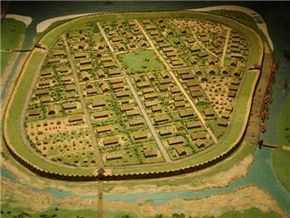

The oldest archaeological findings in Aarhus are glass pearls, which date to the end of the 7th century. Half buried longhouses, used both as homes and workshops for the Vikings have also been found.[20] In the houses and the adjoining archaeological layers, combs, jewellery and basic multi-purpose tools have been found that indicate the settlement is from approximately year 900. [citation needed]
The finding of six runestones in and around Aarhus indicates the city had some significance around year 1000 as only wealthy nobles traditionally used them.[21] The centre of Aarhus was once a pagan burial site until Aarhus' first church, Holy Trinity Church, a timber structure, was built upon it during the reign of Frode, King of Jutland, around 900.[22]
17th–18th centuries

During the wars of the 17th century, it is probable that the city suffered in a significant way. Fortifications still exist south of the city as a reminder of the German imperial campaigns between 1627 and 1629. [citation needed]
In spite of these and other misfortunes, such as plague and city-wide fires, Aarhus was still quite a significant city in Denmark due to its favourable geographical position which was of significant importance for trading.
19th century
In the 19th century, the city gained more independence from the dominance of Copenhagen and Hamburg. While it had been the third largest city in Jutland during the early 19th century, its population surpassed Randers in 1840 [citation needed] and in 1850, Aalborg, thus becoming the largest city in Jutland and the second largest in Denmark.
The city's material prosperity continued to increase as the harbour expanded and the railway network grew. Culturally, it marketed itself as the "Capital of Jutland" and expanded many of its cultural institutions like the national library, universities, the Aarhus Theatre and hospitals.
Geography
The city lies roughly at the geographical centre of Denmark on the peninsula of Jutland. Forests reach from the south into the city to within a kilometre (0.6 mi) of the city centre, because the city has grown around the forest, and some forest areas are completely surrounded by the city, such as Riis Skov. The city is built mostly around the harbour, which is predominantly industrial, although a large recreational marina is situated south of it as an extension.
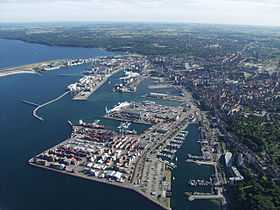
While some of the highest points in Denmark are close to the city, the general landscape is typically hilly, interspersed with forests and meadows; the city itself is very hilly north of the centre (by Danish standards, that is; see Highest hill, Denmark).
The city lies at the junction of railway lines from all parts of the country. To the south west (about 21 km (13 mi), by rail) lies a picturesque region that contains the Gudenå. Several larger lakes extend West from the Skanderborg railway junction and rise to heights exceeding 152 metres (499 ft) at Himmelbjerget. The railway traverses this district of moorland and woodland to Silkeborg.
Administrative divisions
Aarhus is divided into several districts and suburbs with its own postal code (Postdistrikter).
Districts (boroughs) inside the second city beltway:
| ||||||||
Demographics
More than 300,000 people live within the city limits of Aarhus,[23] while an additional 500,000 live in the surrounding local area of the East Jutland region. Aarhus is also a major part of the larger East Jutland metropolitan area with 1,200,000 inhabitants, which makes East Jutland the second most-populated area in Denmark, after the Copenhagen area.[24][25]
The population of Aarhus is both younger and better-educated than the national average.[25] This is often attributed to the high concentration of educational institutions and facilities in the area.
Nearly 12% of the population are immigrants, which is high for Denmark, but modest when compared to some other European cities. The largest immigrant groups (January 1, 2008) are Palestinians (4,644), Turks (4,089), Somalis (3,476), Iraqis (3,140), Vietnamese (2,382), and Iranians (2,199). [citation needed] These groups live mainly in the western parts of Aarhus, where the Gellerup area is infamous for its high concentration of immigrants (88%, 2006). The vast majority of the immigrants in Gellerup are Arabs, Turks and Somalis. Other large immigrant groups in Aarhus include Germans (1,573), Poles (1,555), Norwegians (1,050), Afghans (958), and Britons (763).
Economy

The harbour is one of the largest industrial harbours in Northern Europe. It has the largest container terminal in Denmark and accommodates the largest container vessels in the world.[26] The facilities are very modern and handle approximately 12 million tonnes of cargo (2006) and are therefore among the 100 biggest containerports in the world.[27] Much agricultural produce is exported, while coal and iron are among the chief imports. [citation needed] The harbour itself is maintained by Århus Stevedore Kompagni A/S originally based in Aarhus but currently operating several harbours around the world.
The region is a major producer of agricultural products with many large farms in the outlying districts. Cattle, pork and grain are the main products with a sizable related refinement industry present. [citation needed]
The Ceres Brewery, part of Royal Unibrew, was originally founded in Aarhus. Royal Unibrew announced the closure of Ceres in 2008.
Culture
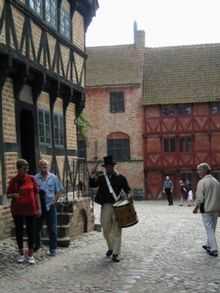
Aarhus is a centre for education on the peninsula of Jutland. It draws students from a large area, especially from the western and southern parts of the peninsula. The relatively large influx of young people and students creates a natural base for cultural activities. There are many cafes and restaurants as well as discothèques, cinemas, museums, amusement parks, and various other entertainment venues. Each year, the town hosts several festivals and concerts, including NorthSide Festival, Aarhus International Jazz Festival and Aarhus Festuge the biggest festival in Scandinavia. The Vestereng park facility is also a site for large popular-music concerts.
One major tourist attraction in Aarhus is The Old Town (Danish: Den Gamle By), which is not actually an old part of the city itself, but a collection of historic Danish buildings gathered from all around the country. The city also hosts the Tivoli Friheden amusement park as well as the deer park situated in the large nearby public forest.
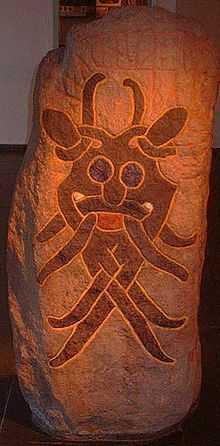
Architecturally impressive sights include the 13th century cathedral in the centre of the city; Århus Domkirke is the tallest cathedral in Denmark, as well as the second longest in Northern Europe, being only 45 cm (18 in) shorter than its counterpart in Trondheim. The Aarhus City Hall is a uniquely designed building drawn by renowned architect Arne Jacobsen, located in the city centre. The city hall is included in the national educational canon for culture as an example of important architectural work.
There are many museums scattered around the city with ARoS being the newest and largest featuring daily exhibits of contemporary art. Other museums include Aarhus Kunstbygning which also features contemporary art, Frihedsmuseet which focuses on the occupation and resistance movement during World War II and Kvindemuseet which showcases feminist history and culture.
Being a comparatively large Danish city, Aarhus has received a fair share of immigrants from various other cultures and is as such also home to one of the few ghettos in Denmark, Gellerup. The international cultures present in the community are an obvious and visible part of the city's daily life and contribute to many cultural flavours uncommon for the North, such as the Arabic themed Bazar West, a market with shopkeepers predominantly of foreign descent. [citation needed]
The city has an active and visible gay and lesbian community which the city officially attempts to promote and nurture.[28] The Aarhus Festuge festival usually includes several exhibits, concerts or events specifically designed for these communities. There are several clubs, discos and cafes aimed at gays and lesbians: Danish D-lite (sports), G bar (disco) or Gaia Vandreklub (hiking club) are a few examples.
It is common for tourist brochures and local politicians to refer to the town with the tongue-in-cheek slogan "The world's smallest big city"[29] reflecting the fact that the city has everything a city needs despite not being a metropolis like London. Another popular, and perhaps better known, phrase to describe the city is "City of Smiles" – a slogan first coined by the city council in the 1930s as an advertising slogan, and which subsequently is used widely in popular culture today.
Main sights
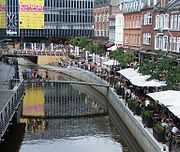

- Århus Domkirke, the tallest and longest cathedral in Denmark.
- Vor Frue Kirke (Church of Our Lady), a large church.
- Aarhus Rådhus (City Hall of Aarhus), drawn by Arne Jacobsen.
- Musikhuset (The Concert Hall of Aarhus)
- Aarhus Universitet (Aarhus University).
- Statsbiblioteket (State library).
- Den Gamle By (The Old Town), an open air museum displaying the old original buildings of not only Aarhus, but several other cities in Denmark.
- Det Jyske Musikkonservatorium (The Jutlandic music conservatory).
- Botanisk Have (Botanical garden).
- Tivoli Friheden, amusement park.
- ARoS Aarhus Kunstmuseum, the main Aarhus arts museum.
- Aarhus Kunstbygning, an arts museum.
- Marselisborg Slot (Marselisborg Palace), the summer-retreat of the Danish royal family.
- Aarhus Theatre, the largest theatre in the city.
- Søsterhøj, a 325 metre tall concrete tower with guyed mast on its top
- Skejby Sygehus, the second largest hospital in Denmark
- Atletion, a combined sports venue
- Kvindemuseet, the Women's Museum
- Den Permanente a popular closed beach area, also providing views of Helgenæs and Samsø across Århus Bay.
- Moesgård Museum, a museum that features many relics from the region, including Gravballemanden.
- Viking Museum
- Godsbanen
Sports
In the southern-Aarhus Marselisborg Park, the sports centre named Atletion is located comprises athletics, the football NRGi Park and the indoor sports NRGi Arena. Several sport clubs have their home ground in Atletion, including AGF Århus, the Danish superliga football team, and Aarhus GF handball team, the 1960 European Cup runner-up. Although basketball is a minor sport in Denmark, Aarhus is considered the main Danish hub of the sport [citation needed], with the local team Bakken Bears being the most successful team in Denmark for the past decade. There are also two American football clubs: Aarhus Frogs and Århus Tigers. Aarhus also have a Division 1 ranked ice hockey team called IK Århus.
Aarhus (and especially Atletion) has served or will serve as the host of many sport events in recent years including:
- 2002 European Women's Handball Championship
- 2005 European Table Tennis Championships
- Denmark Open in badminton
- UCI Women's Road Cycling World Cup
- 2006 World Orienteering Championships
- 2006 World Artistic Gymnastics Championships
- GF World Cup; the world's largest handball tournament for women
- DanceSport IDSF World Standard 2006
Education
The town is home to Aarhus University, Aarhus Technical College, The Danish School of Journalism, the Royal Academy of Music in Aarhus, VIA University College, Aarhus School of Architecture, KaosPilots and several other higher education centres. It is possible to receive higher education in many areas, from engineering and dentistry to language and theology.
As of January 1, 2012 Aarhus University was the largest university in Denmark if measured by the amount of students enlisted.[30] The university has approximately 41,500 Bachelor and Master students enlisted and further about 1,500 Ph.D. students.[30] Aarhus University is ranked among the top 100 universities in the world by several of the most influential and respected rankings.[31]
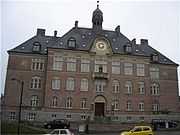
Politics
The city council consists of 31 members elected for 4-year terms. Anybody eligible to vote and residing in Aarhus municipality can run for a seat on the city council. After elections have determined the members of the city council, the council elects a mayor, 2 deputy mayors and 5 councilmen.[32] The current Mayor of Aarhus is Jacob Bundsgaard of the Social Democrats, who took over after Nicolai Wammen in August 2011. Wammen wanted to focus on the upcoming election for Parliament.
The city is divided into 6 minor administrative bodies which together constitute the magistrate led by the mayor and the 5 elected councilmen as political and administrative directors. The 6 magistrate departments of the city are the "Mayor's Magistrate", "Social and Employment Magistrate", "Technology and Environment Magistrate", "Health and Social Magistrate", "Culture and Service Magistrate" and "Children and Youth Magistrate" and handle all the day-to-day operations of the city.
Aarhus is the seat of Aarhus Municipality. Until the 2007 Danish Municipal Reform, which replaced the Danish counties with five regions, it was also the seat of Aarhus County, which has now been disbanded in favour of the new Region Midtjylland, its seat located in Viborg.
Transport

Aarhus Airport is located 40 km (25 mi) north-east of Aarhus in Tirstrup, the bigger Billund Airport is situated 95 km (59 mi) south-west of Aarhus. There have been plans for constructing a new, bigger airport for a long time, but so far, the plans have not been realised.
Aarhus is served by commuter rail that connects the city itself with neighbouring towns. The main station in Aarhus is Aarhus Central Station, which is located in the city centre. Most city bus lines go through the inner city and pass through either Park Alle or Banegårdspladsen (lit. English: "Central Station Square") or both. County and Inter-city buses terminate at Aarhus Bus Terminal which is located 900 meters north-west of Banegårdspladsen, and in front of the Radisson SAS Scandinavia hotel at Margrethepladsen. The long-distance busses of linie888 connect Aarhus to other cities in Jutland and Zealand.[33]
The Danish ferry company Mols-Linien connects Aarhus with Copenhagen (located on the isle of Zealand). The fastest ferries in the world (100 km/h) operate up to 10 times daily from the port of Aarhus to the port city of Sjællands Odde. The ferries transport both private vehicles and the line888 busses. The German based ferry company Förde Reederei Seetouristik has since 2011 been a competitor with a line from Aarhus to Kalundborg on Zealand, the competition with Mols-linien was extended in summer 2012 as they inserted a fast ferry on the line.
Aarhus has a free bike sharing system, Aarhus Bycykler (Aarhus City Bikes). The bicycles are available from 1 April to 30 October at 57 stands throughout the city and can be obtained by placing a DKK 20 coin in the release slot, just like caddies in a supermarket. The coin can be retrieved when the bike is returned.[34] Bicycles can also be hired from many shops.
The Aarhus Letbane is a planned tram-train project which will link two railway lines with a new light rail route through the city.[35]
Twin towns — Sister cities
Aarhus is twinned with seven cities: Originally the cities had most co-operation within the public school, culture and welfare sectors, but now the co-operation is extended to also cover commercial interests.
The cities are:[36]
 Bergen, Norway (since 1946)
Bergen, Norway (since 1946) Gothenburg, Sweden (since 1946)
Gothenburg, Sweden (since 1946) Turku, Finland (since 1946)
Turku, Finland (since 1946) Kujalleq, Greenland (since 1962)
Kujalleq, Greenland (since 1962) Harbin, China (since 1984)
Harbin, China (since 1984) St. Petersburg, Russia (since 1989)
St. Petersburg, Russia (since 1989) Rostock, Germany (since 2006)
Rostock, Germany (since 2006)
Apart from the sister cities Aarhus has a close relation with Novi Sad in Serbia. [citation needed]
Notable people
Politics
- H. C. Hansen, prime minister
- Hans Hedtoft, prime minister
- Svend Auken, minister of labour, environment & energy
- Svend Unmack Larsen, minister of justice (1939–1940), mayor of Aarhus (1945–1958)
- Nicolai Wammen, current minister of European affairs, mayor of Aarhus (2006–2011)
Science
- Lars Bak, computer scientist[37]
- Ole Barndorff-Nielsen, statistician
- Lene Hau, physicist
- William Hovgaard, professor of naval design and construction
- Ole Rømer, astronomer
- Jens Christian Skou, Nobel laureate
- Bjarne Stroustrup, computer scientist
- Ole Worm, physician, scholar and antiquarian
Sports
- Martin Jørgensen, footballer
- Flemming Povlsen, footballer
- Marc Rieper, footballer
- Stig Tøfting, footballer
- Martin Kampmann, UFC Fighter
Music and culture
- Morten Børup, composer (1446–1526)[19]
- Steffen Brandt, singer and composer
- Under Byen, a post-rock band
- Helena Christensen, supermodel
- Ida Corr, singer
- Tina Dickow, singer
- Uffe Elbæk, politician and founder of the first KaosPilot school in the world, which was founded in 1991 in Aarhus
- Henrik Ernst Grosmann, cantor, composer (1732–1811)[19]
- Hatesphere, metal band
- Thomas Helmig, singer
- Gitte Hænning, singer and film star
- Illdisposed, metal band
- Michael Learns to Rock, soft rock band
- Anne Linnet, singer
- Nephew, rock band
- Carpark North, electronic rock band
- Kaare Norge, guitarist
- Jørgen Leth, poet, director, author and journalist
- Niels Malmros, director, screenwriter and Physician
- Medina, singer
- Liam O'Connor or L.O.C., the best-selling rapper in Denmark and founder of the famous and special Aarhus-style in Danish hiphop
- Renee Simonsen, supermodel and author
- Wayne Siegel, composer, professor of electronic music at the Royal Academy of Music
- Lis Sørensen, singer
- John Tchicai, jazz musician
- Spleen United, electronic rock band
- VETO, indie rock band
- Kurt Westergaard, cartoonist
In popular culture
In Denmark, an "Aarhus story" — similar to a Molbo story — is a kind of derogatory ethnic joke. Such stories about the citizens of Aarhus began in the early 20th century and the term continues to be used colloquially. For example, one popular Aarhus story goes as follows. "Have you heard about the Aarhus citizen who was leafing through a phonebook and remarked: 'Jensen, Jensen, Jensen, Jensen, Jensen... How many phones does this guy have?'".[38] And a story referring to the local beer TOP goes like this "Why does the crown caps of the beers in Aarhus says TOP? Then the Aarhusians knows which end of the bottle should be opened!". The majority of the Aarhus stories are trying to convey the Aarhus citizens as stupid and many of them plays with the specialities of the city or the old and somewhat friendly cultural feud between the citizens of Aarhus (representing the Jutes) and the citizens of Copenhagen (representing the Zealanders).[39]
References
- ↑ 1.0 1.1 1.2 "Vision Østjylland", Miljøministeriet, 20. august 2008 (Danish), a description of the East Jutland metropolitan area
- ↑ 2.0 2.1 BEF44: Population 1st January, by urban areas database from Statistics Denmark
- ↑ 3.0 3.1 "Kommuner på landkortet - Danmarks Statistik". Dst.dk. Retrieved 2013-03-25.
- ↑ "English: Aarhus Kommune". Aarhus.dk. 2012-09-17. Retrieved 2013-03-25.
- ↑ http://www.aarhus.dk/~/media/Subsites/Aarhus-Wind-Energy/Dokumenter/Working-and-living.ashx
- ↑ Bridgwater, W. & Beatrice Aldrich. (1966) The Columbia-Viking Desk Encyclopædia. Columbia University. p. 11.
- ↑ "Danish Befolkningsforhold i Østjylland, Miljøministeriet, august 2008
- ↑ Gesta Hammaburgensis ecclesiae 2.4.
- ↑ 9.0 9.1 VisitAarhus (2011). The Aarhus River
- ↑ VisitAarhus (2011). History of the city
- ↑ Wiktionary (2011). å: Noun
- ↑ jp.dk (2010). Århus skifter navn
- ↑ Politiken.dk (2010) Århus skifter navn
- ↑ Børsen (2010) Århus skifter navn
- ↑ "Århus mayor prefers Aarhus". Copenhagen Post. 2010-03-15.
- ↑ "Dobbelt-a i modvind i Aarhus". Jyllands-Posten. 2011-05-05. (Danish)
- ↑ "Danish Placename Commission". Stednavneudvalget.ku.dk. Retrieved 2011-05-28.
- ↑ "Århus eller Aarhus?". Danish Language Committee. 2011. (Danish)
- ↑ 19.0 19.1 19.2 The New Grove Dictionary of Music and Musicians.
- ↑ Hans Skov, "Aros 700–1000", in: Vikingernes Aros Århus 2005, 15–39.
- ↑ Gundhild Øeby Nissen, "Runesten", in: Vikingernes Aros Århus 2005, 46–51.
- ↑ Damm, Annette. Viking Aros (2005) ISBN 87-87334-63-1
- ↑ Aarhus Kommunes Statistiske Årbog, 2005
- ↑ Danmarks Statistik 2006a (Danish)
- ↑ 25.0 25.1 Peter Bro, Ph.D.-studerende, M.Sc., Aalborg Universitet, Henrik Harder, Lektor, Ph.D. HD.O MAA, Aalborg Universitet (2007). "Fremtidens Byudvikling i Østjylland" (PDF). (Danish)
- ↑ "OTHER DANISH PORTS". Maerskbrokeragency.com. Retrieved 2013-06-14.
- ↑ XII.Godsomsætning, Århus Havn, 2000 (Danish)
- ↑ Homo i Århus at Aarhus.dk (Danish)
- ↑ "Holiday Djursland and Mols". Sologstrand.com. Retrieved 2011-05-28.
- ↑ 30.0 30.1 "Aarhus Universitet runder 40.000 studerende: Business Aarhus". Businessaarhus.dk. Retrieved 2013-03-25.
- ↑ "Rankings". Au.dk. 2013-01-23. Retrieved 2013-03-25.
- ↑ Byråd, Aarhus Municipality, July 15, 2003 (Danish)
- ↑ "linie888". Retrieved 30 July 2012.
- ↑ "Aarhus Bycyckel". Retrieved 30 July 2012.
- ↑ "Aarhus tram-train project gets the go-ahead". Railway Gazette International. 10 May 2012.
- ↑ "Venskabsbyer: Aarhus Kommune". Aarhus.dk. Retrieved 2013-03-25.
- ↑ Schenker, Jennifer L. (November 12, 2008). "Google's Chrome: The Danish Magic Inside". Businessweek. Retrieved 6 December 2013.
- ↑ H.A. Yearhouse, "De første 59 Aarhus-historier", Chr. Erichsens Forlag 1973.
- ↑ Aarhus stories Den Gamle By
External links
| Wikivoyage has a travel guide for Aarhus. |
Coordinates: 56°09′26″N 10°12′39″E / 56.1572°N 10.2107°E
| Wikimedia Commons has media related to Aarhus. |
- Aarhus Kommune, official city portal in English
- Visit Aarhus
- Aarhus City Info
- Virtual Aarhus (newer)
- Virtual Aarhus (older)
 Texts on Wikisource:
Texts on Wikisource:
- "Aarhus". The Nuttall Encyclopædia. 1907.
- "Aarhus". Encyclopædia Britannica (11th ed.). 1911
- "Aarhus". Catholic Encyclopedia. New York: Robert Appleton Company. 1913.
- "Aarhus (city)". Collier's New Encyclopedia. 1921.
| ||||||||
| ||||||||||||||||
| |||||||||||||||||||||||||||||||||||||||||||||||||||||||||||||||||||||||||||||||||||||||||||||||||||||||
| |||||

